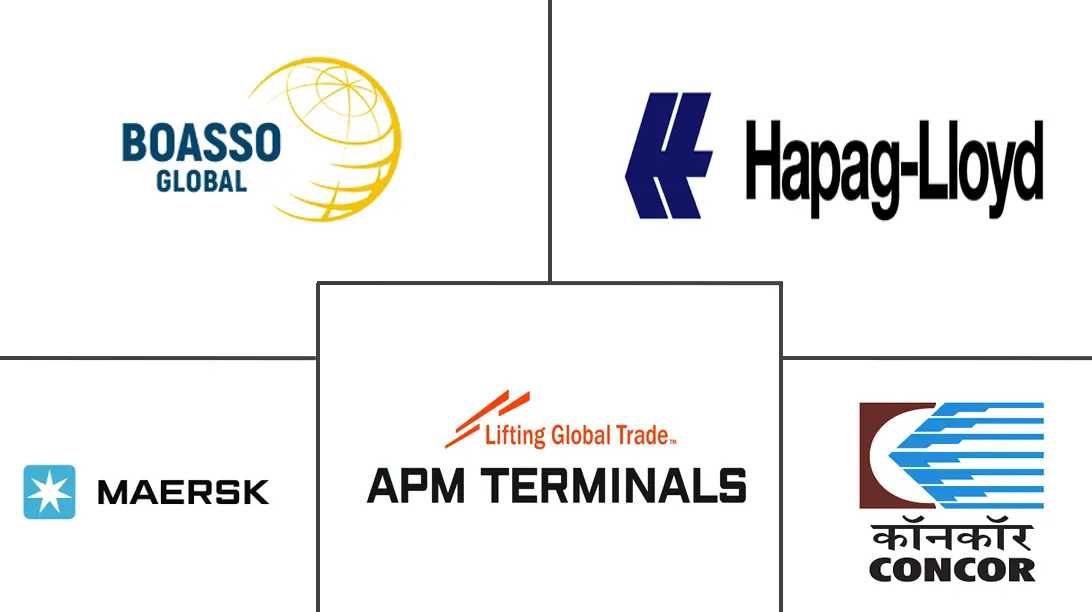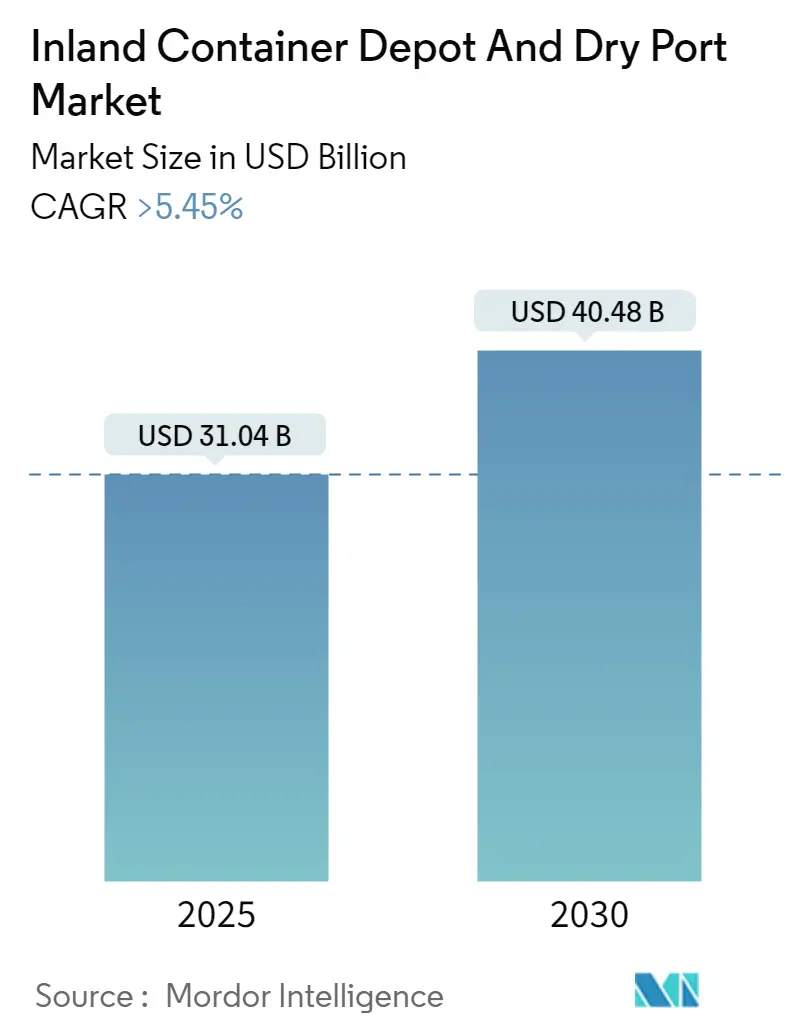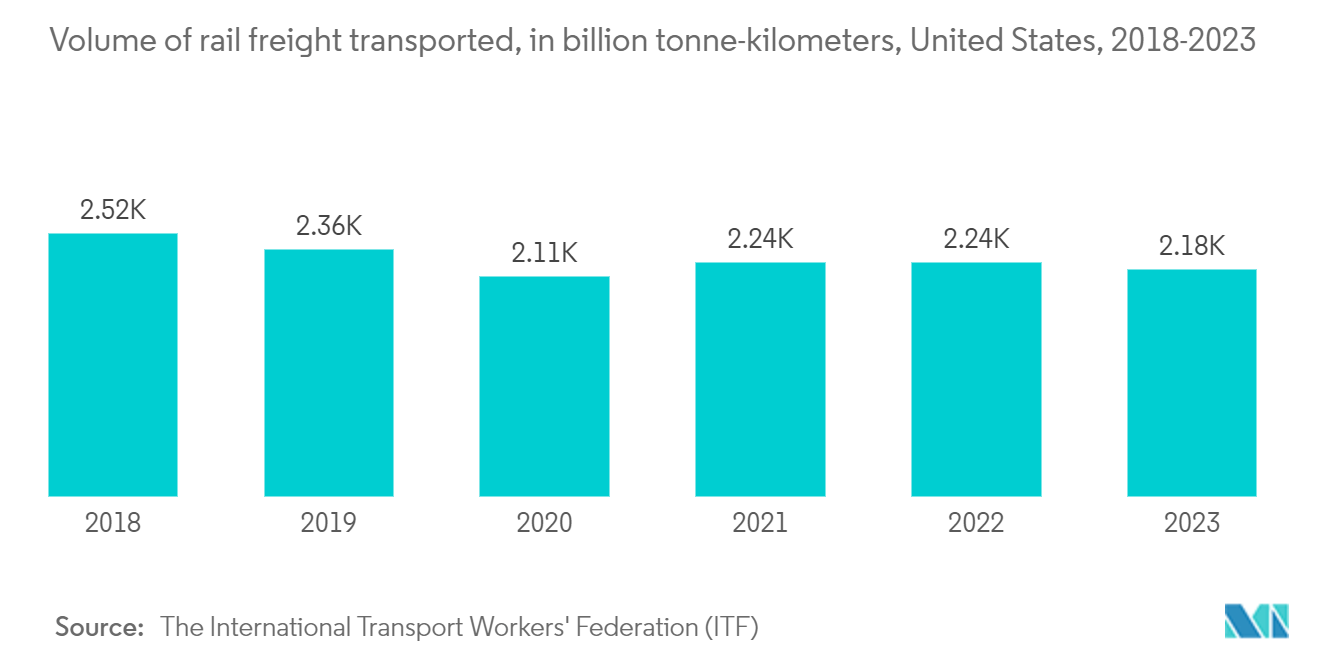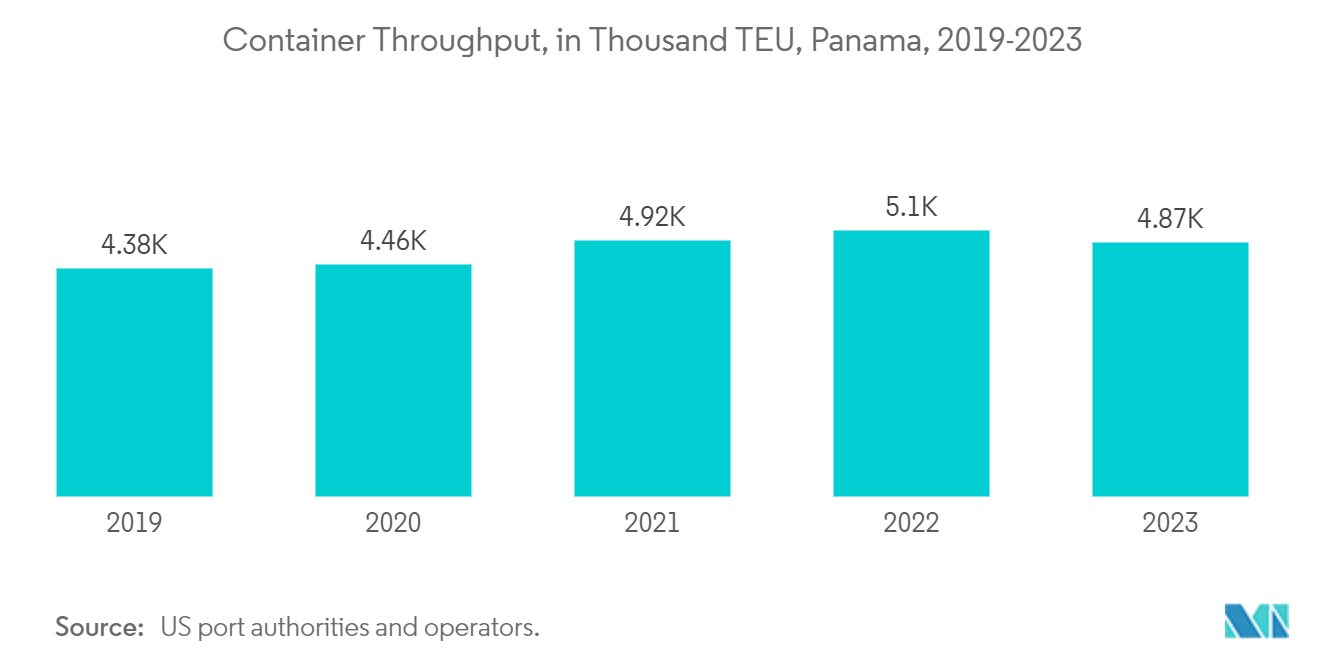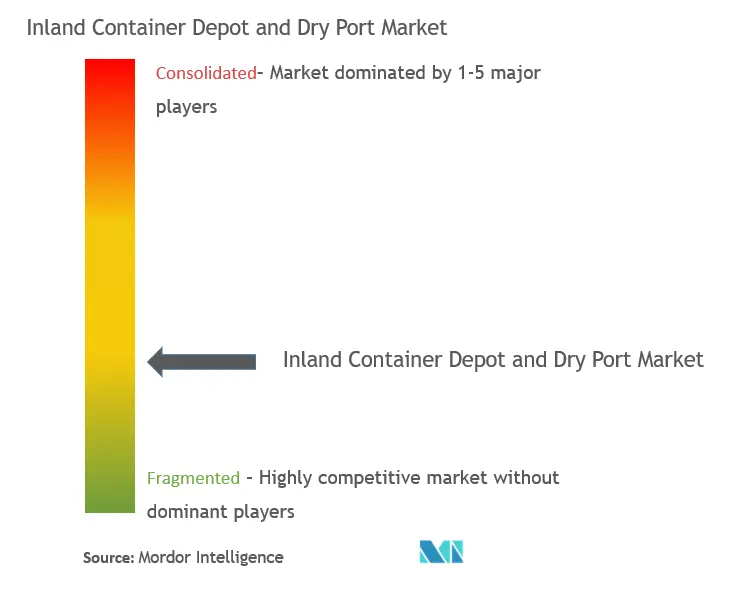Inland Container Depot and Dry Port Market Analysis
The Inland Container Depot And Dry Port Market size is estimated at USD 31.04 billion in 2025, and is expected to reach USD 40.48 billion by 2030, at a CAGR of greater than 5.45% during the forecast period (2025-2030).
- The inland container depot and dry port industry faced a downturn due to port closures, congestion, and fuel price hikes, largely due to the COVID-19 pandemic. In 2020, global container transport volumes dipped by approximately 0.8%, directly impacting the market studied. Conversely, a recent surge in container freight rates, attributed to the Red Sea crisis, has dissuaded major players from investing in container storage and maintenance.
- Companies opting for inland container depots (ICDs) tailor their choices based on the nature of the cargo, which can range from cars and merchandise to crude oil and minerals. After the COVID-19 pandemic, the global market witnessed rising demand for ICDs. This surge was fueled by the expanding domestic and international e-commerce markets, improving trade relations, and the proliferation of free-trade agreements. Notably, global goods trade hit USD 2 trillion in 2023, as reported by the UN Trade and Development, a trend expected to persist, propelling market growth.
- The market's growth is primarily driven by escalating maritime trade and the increasing demand for container handling services. However, market growth is restrained due to the challenges of high port and storage service costs. The market is poised for new opportunities, especially with the advent of cutting-edge technologies like artificial intelligence, automation, IoT, and robotics.
- While Asia-Pacific leads the market, North America emerges as the fastest-growing region. Asia-Pacific, witnessing a surge in new port investments, stands out, with India alone injecting over USD 82 billion into 400+ ports. Not to be outdone, China, Singapore, Japan, and the Philippines actively embrace new technologies in their port developments. In contrast, North America boasts a robust presence of port and container handling entities.
Inland Container Depot and Dry Port Market Trends
Multimodal Connectivity Boosts Demand for Inland Container Depots
- The push for sustainability in freight and logistics has propelled the rise of multimodal transportation. This approach emphasizes using multiple modes of transport (trucks, trains, ships, etc.) to ensure cargo rigidity and prevent damage during transitions. Consequently, there has been a surge in demand for containerized cargo, given their solid and durable nature. This uptick in container demand has directly translated into a heightened need for inland container depots and dry ports.
- Enhanced rail and road connections make inland container depots (ICDs) more accessible and efficient, fueling market growth. By bridging seaports and inland areas, these depots are becoming pivotal for intermodal transportation, driving up the need for container storage and maintenance services.
- The logistics industry is increasingly turning to rail freight as a key component of its multimodal services, aiming for more efficient cargo movement in each trip. This shift is directly amplifying the demand for containerized transport, subsequently spiking the need for ICDs.
- With the surge in rail freight volumes, the demand for ICDs is poised to follow suit. Notably, the United States witnessed a steady rise in rail freight volumes from 2016, culminating in 2.18 trillion tonne-km in 2023. This trend is not exclusive to the United States; similar patterns are seen globally.
- Multimodal connectivity, which blends road, rail, and sometimes waterway transport, is at the core of this surge. ICDs, serving as central hubs for these modes, facilitate seamless cargo transfers, enhancing overall transport efficiency and trimming transit times.
- This efficiency, cost savings, and the ability to navigate modern supply chain complexities make ICDs increasingly indispensable. As global trade expands, the significance of ICDs in the broader transport network is only set to grow.
The Americas is the Fastest-growing Region
- International trade significantly bolsters the economic landscapes of the Americas. North America's ports, serving as crucial trade gateways, witness the transit of billions of tons of cargo annually, facilitated by ships, trains, and trucks.
- Latin America, contributing around 7% to global maritime trade, predominantly ships raw minerals, vegetables, and a diverse range of food products. This surge in exports has, in turn, fueled the need for more containers and inland container terminals. The region's trade dynamics are intricately linked to the world's primary maritime routes, notably Europe, North America, and, increasingly, Asia-Pacific.
- The top 20 ports and container terminals in Latin America, as highlighted by an industry association, accounted for over 80% of the region's total throughput. In 2023, imports of containerized goods into SAEC (East Coast South America) from the Far East saw a steady rise, with volumes spiking by 14.5% in the initial eight months, translating to an extra 20,000 TEU monthly.
- While the spot market for these goods exhibited volatility, rates by October had only dipped by -2% from the year's start, averaging at USD 2,716 per FEU over the period but fluctuating between USD 2,048 and USD 3,286.
- This data underscores the mounting sea freight demand across the Americas, propelling increased container throughput and bolstering the market studied.
Inland Container Depot and Dry Port Industry Overview
The market is relatively fragmented, with several players operating depots on global and regional levels like A.P. Moller-Maersk, Boasso Global, Container Corporation of India (CONCOR), APM Terminals, and Hapag Llyod. As many companies are jumping into the market, the market is expected to grow during the forecast period. Additionally, to accelerate international trade, governments of several countries in Europe and Asia are offering container depot services, which is further expected to strengthen the market
Inland Container Depot and Dry Port Market Leaders
-
Boasso Global
-
Maersk
-
Container Corporation of India (CONCOR)
-
APM Terminals
-
Hapag Llyod
- *Disclaimer: Major Players sorted in no particular order
Inland Container Depot and Dry Port Market News
- February 2024: Quala and Boasso Global, key players in the tank trailer and ISO tank container industry specializing in cleaning, maintenance, storage, and transportation services, completed the acquisition of Mainport Tank Cleaning BV, Mainport Tank Container Services Botlek BV, and Mainport Tank Container Services Moerdijk BV – collectively referred to as "MTC" – from Matrans Holding BV, headquartered in Rotterdam, Netherlands. MTC is renowned for its excellence in tank cleaning and ISO tank container depot services.
- January 2024: Maersk established a 'center of excellence' at the East Midlands Gateway campus. The campus, featuring a 695,000 sq ft warehouse, a rail terminal managed by Maritime, and a 14-acre container depot, all situated within a freeport, is well-positioned to champion this streamlined approach. Moreover, its strategic location, near major UK ports like Felixstowe, Liverpool, and Southampton, alongside easy access to the nation's rail, road network, and key airports, enhances its allure.
Inland Container Depot and Dry Port Industry Segmentation
An inland container depot (ICD) is purpose-built for the storage, maintenance, and handling of shipping containers. These depots boast the necessary infrastructure for container inspections, repairs, cleaning, and other maintenance tasks. In the hinterlands, away from major ports, ICDs—also known as dry ports—serve as vital container storage facilities. They are pivotal for shipping companies, acting as interim storage points before and after containers are moved through ports. ICDs boast robust rail and road connections to major ports, facilitating seamless transportation. By bridging the gap between ports and inland areas, ICDs enhance the accessibility of freight forwarders and shipping lines to a broader customer base.
The market is segmented by service (storage, handling, maintenance, and repair), type of container (general and refrigerated [reefer]), and geography (North America, Europe, Asia-Pacific, and LAMEA). The report offers market size forecasts in values (USD) for all the above segments.
| By Service | Storage | ||
| Handling | |||
| Maintenance and Repair | |||
| By Type of Container | General | ||
| Refrigerated (Reefer) | |||
| By Geography | North America | United States | |
| Canada | |||
| Europe | Germany | ||
| UK | |||
| France | |||
| Russia | |||
| Spain | |||
| Rest of Europe | |||
| Asia-Pacific | India | ||
| China | |||
| Japan | |||
| Rest of Asia-Pacific | |||
| South America | Brazil | ||
| Chile | |||
| Middle East | United Arab Emirates | ||
| Saudi Arabia | |||
| Rest of Middle East | |||
Inland Container Depot and Dry Port Market Research FAQs
How big is the Inland Container Depot And Dry Port Market?
The Inland Container Depot And Dry Port Market size is expected to reach USD 31.04 billion in 2025 and grow at a CAGR of greater than 5.45% to reach USD 40.48 billion by 2030.
What is the current Inland Container Depot And Dry Port Market size?
In 2025, the Inland Container Depot And Dry Port Market size is expected to reach USD 31.04 billion.
Who are the key players in Inland Container Depot And Dry Port Market?
Boasso Global, Maersk, Container Corporation of India (CONCOR), APM Terminals and Hapag Llyod are the major companies operating in the Inland Container Depot And Dry Port Market.
Which is the fastest growing region in Inland Container Depot And Dry Port Market?
North America is estimated to grow at the highest CAGR over the forecast period (2025-2030).
Which region has the biggest share in Inland Container Depot And Dry Port Market?
In 2025, the Asia Pacific accounts for the largest market share in Inland Container Depot And Dry Port Market.
What years does this Inland Container Depot And Dry Port Market cover, and what was the market size in 2024?
In 2024, the Inland Container Depot And Dry Port Market size was estimated at USD 29.35 billion. The report covers the Inland Container Depot And Dry Port Market historical market size for years: 2020, 2021, 2022, 2023 and 2024. The report also forecasts the Inland Container Depot And Dry Port Market size for years: 2025, 2026, 2027, 2028, 2029 and 2030.
Inland Container Depot and Dry Port Industry Report
Statistics for the 2025 Inland Container Depot And Dry Port market share, size and revenue growth rate, created by Mordor Intelligence™ Industry Reports. Inland Container Depot And Dry Port analysis includes a market forecast outlook for 2025 to 2030 and historical overview. Get a sample of this industry analysis as a free report PDF download.

